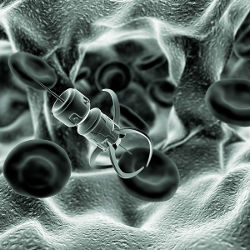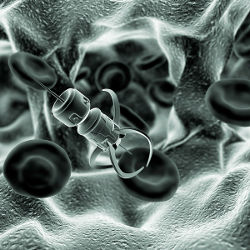
When a team of researchers at Bar-Ilan University in Israel recently announced they had successfully implanted DNA-based nanorobots inside living cockroaches—possibly paving the way for a revolution in cancer treatment—it marked the latest in a series of promising innovations to emerge from the synthetic biology community over the past decade.
In recent years, biotechnologists have started to come tantalizingly close to engineering next-generation drugs and vaccines, DNA-based computational systems, and even brand-new synthetic life forms. Amid all these advances, however, the development of synthetic biology software has largely failed to keep up with the pace of innovation in the field.
With only a handful of commercial software tools at their disposal, most synthetic biologists have had no choice but to build their own bespoke systems to support the intense data modeling needs of molecular engineering.
"Computer science is critically important to synthetic biology," says Drew Endy, an associate professor of biotechnology at Stanford University and co-founder of BIOFAB, an ambitious effort to create open source biological parts for molecular engineering. Yet surprisingly few computer scientists have chosen to enter the field.
That situation may be slowly changing, as a handful of developers have started to delve into the challenges of molecular engineering. One of the most promising initiatives to date has come from Autodesk, which is developing a software platform designed for synthetic biology, 3D bioprinting, 4D printing, and DNA nanotechnology, code-named Project Cyborg.
"DNA is the universal programming language," says Andrew Hessel of Auto-desk’s Bio/Nano/Programmable Matter group, who sees enormous potential in applying the principles of computer science to biological applications. "The architectures of biology—from proteins to metabolism to cells to tissues to organisms and ecosystems—it’s all just layered systems on systems. But you need the foundation of silicon computing to support that work. Otherwise, DNA is just as unreadable as ones and zeros."
Project Cyborg offers researchers and designers a set of Web-based computer-aided design (CAD) tools that allow the engineering of nano-scale objects in a visual design framework. The system allows users to store and manipulate that data in the cloud. Designs can be fabricated by a number of DNA "print shops" around the world (such as DNA2.0 in Menlo Park or Gen9 in Boston).
Thinking about the design of living things, Hessel has discovered irresistible parallels between synthetic biology and computing. "Cells are just living, squishy parallel processors," says Hessel. "They are fully programmable."
One of Project Cyborg’s best-known beta testers is Shawn Douglas at the University of California San Francisco, who is using the Autodesk tools to design cancer-fighting nanorobots that have already proven effective at isolating and attacking cancer cells in a lab environment.
The nanorobots work by twisting into a precise configuration that allows them to attach to targeted cells, looking for signals from antigens on the cells’ surface that flag them as cancerous. The nanorobots then lock onto the cell, breaking it open and engaging the cell receptors to trigger a response that destroys the cancer cell.
Transforming DNA strands into predetermined shapes requires a complex and delicate process of manipulating nucleotides to assemble in a preordained sequencing, precisely ordering the genomic components of adenine, cytosine, guanine, and thymine. It is painstaking work, involving thousands of detailed specifications.
Douglas initially used the open source drawing tool Inkblot (and in some cases, pen and paper). Frustrated with the limitations of the available software, he drew on his own background in computer science to develop an open-source software tool known as Cadnano to accelerate the process.
The work paid off, and soon researchers in his lab were able to complete dozens of designs per month, when previously they were only completing one. They soon began to take on more challenging design projects.
One project originated with Douglas’ work on DNA as a graduate student at Harvard University in the mid-2000s, working with collaborators Hendrik Dietz and William Shish to create complex shapes made out of DNA strands. By manipulating the order of nucleotides within the famous double-helix structure of DNA, they were able to influence the way one strand interacted with another: in effect, programming them to bend, join together, and combine into new shapes.
Douglas continued to pursue his studies at Harvard with computational biology pioneer George M. Church and Ido Bachelet, a researcher in experimental pharmaceutics who would go on to lead the work on DNA-based origami robots at Bar-Ilan University. Eventually, they began to work on progressively more ambitious DNA experiments.
In 2012, Douglas and Bachelet published a seminal article in Science about their work, chronicling the results of their experiments in designing an autonomous DNA nanorobot capable of delivering molecular "payloads" to attack six distinct types of cancer cells. Their study found this approach worked particularly well with certain kinds of leukemia cells, while leaving 99% of healthy cells untouched.
If successful, nanorobot-based cancer treatment would represent a huge leap forward from the brute force therapies of traditional chemotherapy and radiation techniques, and promises to relieve the suffering and prolong the lives of countless millions of cancer patients.
Elsewhere, researchers at Duke University, the University of Rome, and Aarhus University have built a "DNA nanocage" with tiny lattices that can open and close in response to temperature signals. This mechanism would allow it to release enzymes in response to environmental conditions, making it theoretically possible to deliver highly targeted medicines in pill form.
For all of their potentially enormous promise, none of these devices has been tested on humans. The potential side-effects and complications remain unclear. Unlike insects, human beings and other mammals will be more difficult to penetrate due to their higher levels of infection-fighting nucleases, but researchers are continuing to work on solutions to that problem.
"Cells are living, squishy processors," says Hessel. "They are fully programmable."
That work will require increasingly complex computer modeling, almost certainly involving more custom application development. Indeed, most of the high-profile synthetic biology work—and funding—has focused on the "application" layer of high-profile solutions, rather than on the far-less-glamorous systems layer that would ultimately enable more and more of these applications to take shape.
"Historically, the engineering tool-kit for biotechnology has not been well-defined," says Endy, who laments the lack of funding support—and apparent interest—in tackling these infrastructure-layer challenges in both the academic or corporate worlds. None of the major university computer science departments devote significant support to synthetic biology, nor (apart from Autodesk) does there seem to be much interest emanating from the corporate software world.
"Teams that get funded to work on solving problems with biology tend to be overdriven by the immediate pressing nature of the situation," says Endy. "That leads to a bias in funding and under-development. We are too focused on the applications."
Endy feels the answer may lie in public-private partnerships, similar to the ones he forged with BIOFAB, which pioneered the development of an open source framework known as BIOBRIC, something akin to a Creative Commons license for biological parts.
"Public-private partnerships can work in biotechnology by allowing academics and professionals to work together in an effective way." says Endy. "Academics are in the business of shipping papers, and biotech companies are over-driven by implementation." Endy sees potentially enormous complementary power at work when the corporate work ethic gets coupled with the academic commitment to getting the fundamentals right.
Moreover, biologists and computer scientists still need to learn how to speak each other’s languages. DNA may be a programming language, but it does not involve a binary system; instead, it is an ordinal system, involving a more complex code of nucleotide sequences. And while most computer programming languages are linear, time-based systems, biology happens in the physical world; it’s a four-dimensional proposition.
Taking computer science from the binary realm of silicon into the four-dimensional, ordinal biological world will inevitably require a steep learning curve, but the potential payoff for humanity is enormous. Says Endy: "The number of miracle moonshots is almost infinite."
Further Reading
Amir, Y., Ben-Ishay, E., Levner, D., Ittah, S., Abu-Horowitz, A., Bachelet, I.
Universal Computing by DNA origami robots in a living animal. Nature Nanotechnology. 9, 353–357 (2014). doi:10.1038/nnano.2014.58.
Douglas, S.M., Bachelet, I., Church, G.M.
A Logic-Gated Nanorobot for Targeted Transport of Molecular Payloads. Science. 335:831–4 (2012).
Mutalik, V., Guimaraes, J., Cambray, G., Lam, C., Christoffersen, M.J, Mai, Q., Tran, A.B., Paull, M., Keaslking, J.D., Arkin, A.P., Endy, D.
Precise and reliable gene expression via standard transcription and translation initiation elements. Nature Methods. 10: 354–360 (2013). doi:10.1038/nmeth.2404
Sissel, J., Iacovelli, F., Falconi, M., Kragh, S., Christensen, B., Frøhlich, R., Franch, O., Kristoffersen, E., Stougaard, M., Leong, K.W., Ho, Y., Sørensen, E.S., Birkedal, V., Desideri, A., Knudsen, B.R.
Temperature-Controlled Encapsulation and Release of an Active Enzyme in the Cavity of a Self-Assembled DNA Nanocage, ACS Nano, 2013, DOI: 10.1021/nn4030543




Join the Discussion (0)
Become a Member or Sign In to Post a Comment